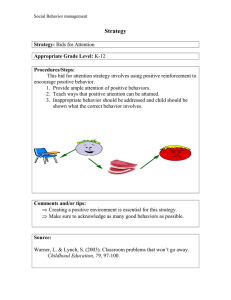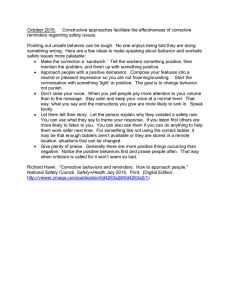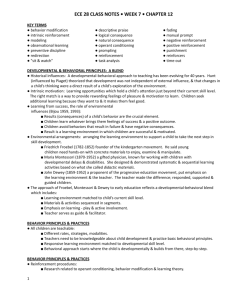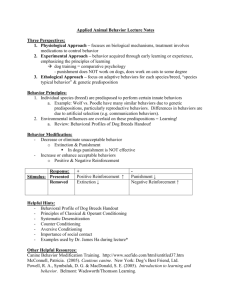Behaviorally Speaking: A Guide for Shaping Child Behavior
advertisement
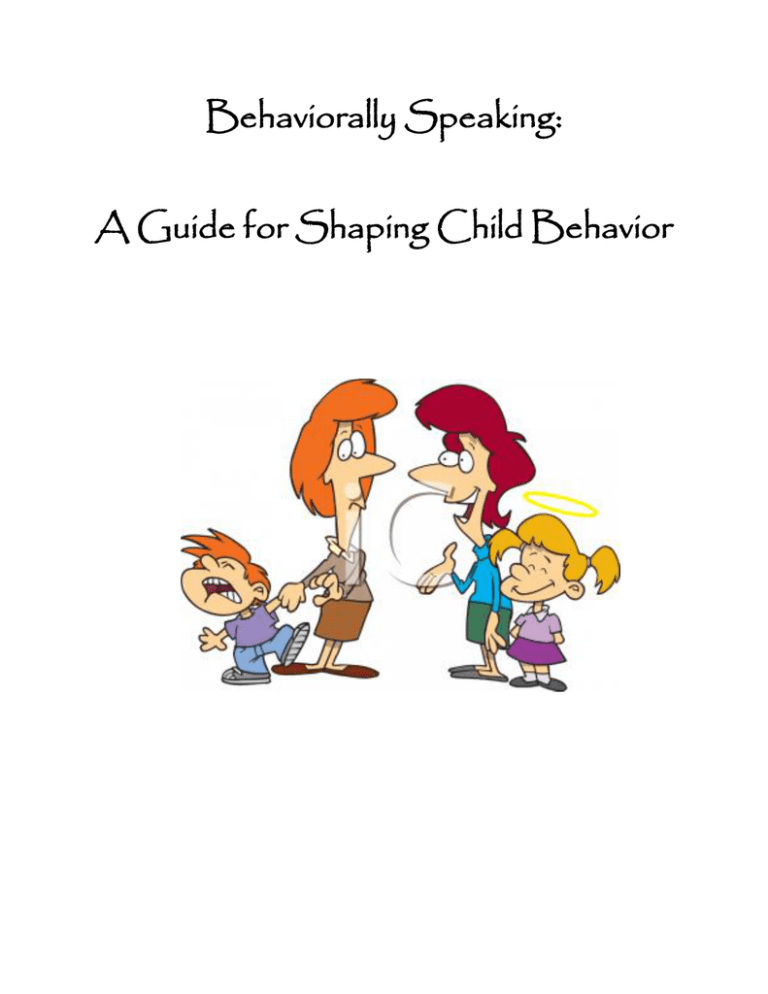
Behaviorally Speaking: A Guide for Shaping Child Behavior There is a Function Stay Positive: Actions Speak to this Behavior? Praise, Praise, Just as Loud As Every behavior has a function! Identifying why a child is engaging in a behavior will help inform a plan to eradicate inappropriate behaviors and increase appropriate behaviors! Praise! Words: Using Using observations of the child and his or her behavior will help determine the function of the behavior. The best way to determine the function of behavior is using the ABC method. A- Antecedent. What is happening right before the behavior occurs? B- The behavior. What is occurring? C- Consequences. What is happening immediately after the behavior occurs? What is the child accessing? Common functions of behaviors: Seeking Attention Escape or avoidance of a demand To meet a sensory need To access a preferred activity or item Altering what happens right before or after a behavior may help reduce that behavior. These changes may be made based on what function of a particular behavior is! Using praise is an excellent strategy for increasing appropriate behavior and decreasing instances of inappropriate behavior. This can be done with siblings, or individual children. When children see others in the environment being praised they will want to reproduce that behavior to gain their own praise, decreasing instances of negative behavior. Praise should be specific. It is also helpful when praise is paired with non-verbal cues, such as thumbs up or a smile. Example: After lunch the Jonny and Claire are told to play quietly in the living room. Johnny does as he is asked, but Claire is running around screaming. You then praise Johnny for his appropriate behavior by saying “I like the way Johnny is playing quietly,” and smiles at him giving thumbs up. Using this consistently and frequently will yield the best results! Catch them being good, look for opportunities to praise throughout the day! Non-Verbal Cues Frequently when we talk as adults we tend to use hand gestures, eye contact, and other forms of non-verbal communication. It is important to recognize that using these with kids is important too! When communicating with children it is important to try to pair messages with gestures and use eye contact to best engage them. When giving praise, try pairing a verbal statement with thumbs up and a smile. When giving corrective feedback be sure to make eye contact and use an appropriate hand gesture. The more consistent your communication is to your children, the more accurate their perception of that communication will be! Example: Dante is running down the hallway. You lock eyes with Dante and firmly says, “Stop running Dante,” while raising your hand showing a stop cue. An Age Old Planned Ignoring Attention Signals Strategy: This is a strategy that is used to reduce inappropriate behavior. It is especially effective for kids that engage in particular behaviors in order to obtain attention. Just as we get tired of reprimanding students and or/waiting for their full attention, students get tired (desensitized) to it as well. Grandma’s Rule The rule: If…X…Then…Y… This is a rule many of us grew up with and is relatively easy to use. This can be used for individual children or groups of children. When you have given a task demand for the child they often may ask to engage in another preferred activity. In order to apply grandma’s rule, you simply answer the child. If (you engage in my task) then you may have a few minutes for your task. There is no punishment involved with this. Every time the child asks to engage in a preferred activity you apply the If…Then… statement. When you use this consistently and follow through on the reinforcement, the child is more likely to comply with your demands. Example: The parent tells her children to do their homework. Daquan asks if he can play on the computer. The parent replies “If you do 10 math problems then you may play on the computer for 5 minutes.” She repeats this until Daquan has completed 10 problems, and then allows him his 5 minutes of playtime. This strategy requires you to choose the inappropriate or problematic behavior ahead of time. You must plan to ignore instance of this behavior and commit to ignoring it. The only instance of acknowledging behavior may be if the child becomes unsafe. If you are inconsistent with ignoring the behavior you may, unknowingly, be intermittently reinforcing the behavior. Intermittent reinforcement will actually increase the likelihood the behavior will continue to occur in the future. Over time, this ignoring should lead to reduced rates of the specified behavior. Example: Shania whines and asks to go to wash her hands during her nightly reading time, even though she has already washed her hands immediately following dinner right before she reads. She continues to ask until her father lets her go. The father begins to ignore these requests until eventually, Shania stops asking to wash her hands. Developing a fun attention signal early on is a great way to avoid having to use your voice, and get children refocused quickly, positively and efficiently. Downtime often leads to misbehavior. Children should begin at-home tasks quickly after directions are given. Using attention signals can often help to grab multiple children’s attention and get them engaged in a particular activity. Signals can be personalized to the personality of the parent and children. There are several options. Some parents like to use different ones for different purposes. Examples: Echo clap: parent claps a pattern and students imitate Teacher: “One two” Students “Eyes on You” Teacher: bum bum bum bum bum Class: bum bum Parent: Simon says game Last instruction leading into a task such as teeth brushing. Reinforcement: Using a Token Make it Stop! What Is It? Economy Punishment Negative urs when the Negative reinforcement occurs when the removal of a stimulus increases a child’s likelihood to engage in a behavior. Despite the term “negative” this is NOT punishment. Positive reinforcement occurs when the presentation of a stimulus increases the future likelihood that a child will engage in a behavior. Either form of reinforcement can be utilized with individual or multiple children. Reinforcement is most effective when it begins at a high rate of consistency and then is used intermittently. Examples: Many parents use behavior charts as a form of positive reinforcement. The parent chooses 2-3 behaviors to target and provides a mark on the chart when the child engages in the specified behaviors. When the child has earned a predetermined amount of marks they receive a larger reward. Many parents remove a preferred activity or object from a child to increase a particular behavior. For example, turning off the lights at night may increase the rate of a child getting in bed and going to sleep. The use of a token economy is a form of positive reinforcement. This system involves providing the child with a token of your choosing when they engage in appropriate and desirable behavior. The child can then “cash in” tokens for predetermined rewards at predetermined values. Examples of tokens may be play money, computer printed pictures, pennies, marbles, or pieces parents may design. Rewards available to children should be explicit so that children have clear expectations as to what they can earn. Behaviors that may result in the child receiving a token should also be specific and explicit so the child understands what they must do to earn. Response Cost: This is a strategy that can be used with older children and adolescents. This entails having the child return tokens when they engage in inappropriate and undesirable behaviors. These behaviors must be made clear to the child and the token amount returned should also be defined. Negative punishment occurs when the removal of a stimulus causes the likelihood of a behavior to occur in the future to decrease. Positive Punishment occurs when the presentation of a stimulus decreases the future likelihood that a child will engage in a behavior. This can also be used with individual or group of children. The more consistent punishment is, the more effective it will be! Examples: Using timeout is a common form of negative punishment, whereby the child loses the opportunity to engage in a desirable activity in order to decrease a disruptive behavior. An example of positive punishment may be presenting a loud noise such as a buzzer when a child engages in an inappropriate behavior that results in a decrease of that behavior.
